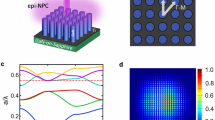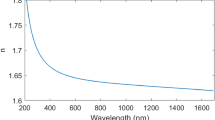Abstract
Ultraviolet light sources, represented by excimer and mercury lamps, are currently used for various applications, including water purification/sterilization, biotechnology, photolithography and surface modification. However, they have the disadvantages of limited portability, low emission efficiency and the presence of harmful constituents. Finding a compact, efficient and environmentally friendly alternative ultraviolet light source is therefore of considerable technological interest. Aluminium-nitride-based semiconductors show promise as materials for this purpose1,2,3,4,5,6,7,8,9,10,11,12,13, but because of difficulties in controlling electronic conductivity, in light-emitting diodes are hampered by low external quantum efficiencies. Here, we use an electron-beam pumping technique, demonstrating an output of 100 mW and a record power efficiency of ∼40% from AlxGa1−xN/AlN quantum wells emitting at ∼240 nm. This achievement is attributed to carrier confinement within the high-quality quantum wells, as well as the appropriate design of sample structures for electron-beam pumping, and may be a milestone in the path to realizing next-generation ultraviolet light sources with great ecological and economic benefits.
This is a preview of subscription content, access via your institution
Access options
Subscribe to this journal
Receive 12 print issues and online access
$209.00 per year
only $17.42 per issue
Buy this article
- Purchase on Springer Link
- Instant access to full article PDF
Prices may be subject to local taxes which are calculated during checkout





Similar content being viewed by others
References
Taniyasu, Y., Kasu, M. & Makimoto, T. An aluminium nitride light-emitting diode with a wavelength of 210 nanometres. Nature 441, 325–328 (2006).
Khan, A., Balakrishnan, K. & Katona, T. Ultraviolet light-emitting diodes based on group three nitrides. Nature Photon. 2, 77–84 (2008).
Li, J., Nam, B., Nakarmi, M. L., Lin, J. Y. & Jiang, H. X. Band structure and fundamental optical transitions in wurtzite AlN. Appl. Phys. Lett. 83, 5163–5165 (2003).
Shatalov, M. et al. Efficiency of light emission in high aluminum content AlGaN quantum wells. J. Appl. Phys. 105, 073103 (2009).
Bhattacharyya, A., Moustakas, T. D., Zhou, L., Smith, D. J. & Hug, W. Deep ultraviolet emitting AlGaN quantum wells with high internal quantum efficiency. Appl. Phys. Lett. 94, 181907 (2009).
Banal, R. G., Funato, M. & Kawakami, Y. Initial nucleation of AlN grown directly on sapphire substrates by metalorganic vapor phase epitaxy. Appl. Phys. Lett. 92, 241905 (2008).
Banal, R. G., Funato, M. & Kawakami, Y. Growth characteristics of AlN on sapphire substrates by modified migration enhanced epitaxy. J. Cryst. Growth 311, 2834–2836 (2009).
Banal, R. G., Funato, M. & Kawakami, Y. Characteristic of high Al-content AlGaN/AlN quantum wells fabricated by modified migration enhanced epitaxy. Phys. Status Solidi c 7, 2111–2114 (2010).
Banal, R. G., Funato, M. & Kawakami, Y. Optical anisotropy in [0001]-oriented AlxGa1–xN/AlN quantum wells (x>0.69). Phys. Rev. B 79, 121308(R) (2009).
Fujioka, A., Misaki, T., Murayama, T., Narukawa, Y. & Mukai, T. Improvement in output power of 280-nm-deep ultraviolet light-emitting diode by using AlGaN multi quantum wells. Appl. Phys. Express 3, 041001 (2010).
Pernot, C. et al. Improved efficiency of 255–280 nm AlGaN-based light-emitting diodes. Appl. Phys. Express 3, 061004 (2010).
Hirayama, H. et al. 222–282 nm AlGaN and InAlGaN-based deep-UV LEDs fabricated on high-quality AlN on sapphire. Phys. Status Solidi a 206, 1176–1182 (2009).
Hirayama, H., Tsukada, Y., Maeda, T. & Kamata, N. Marked enhancement in the efficiency of deep-ultraviolet AlGaN light-emitting diodes by using a multi quantum-barrier electron blocking layer. Appl. Phys. Express 3, 031002 (2010).
Narukawa, Y. et al. Ultra-high efficiency white light emitting diodes. Jpn J. Appl. Phys. 45, L1084–L1086 (2006).
Yamada, M. et al. InGaN-based near-ultraviolet and blue-light-emitting diodes with high external quantum efficiency using a patterned sapphire substrate and a mesh electrode. Jpn J. Appl. Phys. 41, L1431–L1433 (2002).
Madelung, O. Semiconductors: Data Handbook 3rd edn, Ch. 2 (Springer, 2003).
Watanabe, K., Taniguchi, T., Niiyama, T., Miya, K. & Taniguchi, M. Far-ultraviolet plane-emission handheld device based on hexagonal boron nitride. Nature Photon. 3, 591–594 (2009).
Miyake, H. et al. Fabrication of deep-ultraviolet light source using AlGaN on AlN/sapphire. 8th International Symposium on Semiconductor Light Emitting Devices (ISSLED), E2 (Beijing, 2010).
Göbel, E. O., Jung, H., Kuhl, J. & Ploog, K. Recombination enhancement due to carrier localization in quantum well structures. Phys. Rev. Lett. 51, 1588–1591 (1983).
Drouin, D. et al. CASINO V2.42—a fast and easy-to-use modeling tool for scanning electron microscopy. Scanning 29, 92–101 (2007).
Miller, R. C., Kleinman, D. A., Nordland, W. A. Jr & Gossard, A. C. Luminescence studies of optically pumped quantum wells in GaAs–AlxGa1–xAs multilayer structures. Phys. Rev. B 22, 863–871 (1980).
Saito, T. et al. UV/VUV photodetectors using group III-nitride semiconductors. Phys. Status Solidi c 6, S658–S661 (2009).
Acknowledgements
The authors would like to thank T. Hitora (president CEO, AlGaN K.K., Japan) for his support regarding the AlGaN photodiodes. This work was partly supported by a Grant-in-Aid for Scientific Research (18069007) and the Global Center-of-Excellence (G-COE) Programme of the Ministry of Education, Culture, Sports, Science and Technology of Japan.
Author information
Authors and Affiliations
Contributions
Y.K. supervised the project. R.G.B. performed crystal growth and PL measurements. Y.K, M.F., T.O. and K.K. conceived and designed the CL experiments. T.O. and K.K. performed the experiments, and T.O. carried out the simulation. All authors participated in the analyses, discussions of the data and writing the paper.
Corresponding author
Ethics declarations
Competing interests
The authors declare no competing financial interests.
Rights and permissions
About this article
Cite this article
Oto, T., Banal, R., Kataoka, K. et al. 100 mW deep-ultraviolet emission from aluminium-nitride-based quantum wells pumped by an electron beam. Nature Photon 4, 767–770 (2010). https://doi.org/10.1038/nphoton.2010.220
Received:
Accepted:
Published:
Issue Date:
DOI: https://doi.org/10.1038/nphoton.2010.220
This article is cited by
-
One-step printable platform for high-efficiency metasurfaces down to the deep-ultraviolet region
Light: Science & Applications (2023)
-
Quantum engineering of non-equilibrium efficient p-doping in ultra-wide band-gap nitrides
Light: Science & Applications (2021)
-
Laser tuning in AlN single crystals
Science China Materials (2021)
-
Optical Performance of Top-Down Fabricated AlGaN Nanorod Arrays with Multi-Quantum Wells Embedded
Nanoscale Research Letters (2019)
-
Flower-like aluminium nitride nanostructures deposited by rf magnetron sputtering on superhard rhodium boride films
Applied Physics A (2019)



